Пособие по обучению практике устной и письменной речи (начальный этап) на английском языке Под ред. О. В. Серкиной
 Скачать 17.03 Mb. Скачать 17.03 Mb.
|
|
Unit 2. The things I like and Dislike. My Shopping. 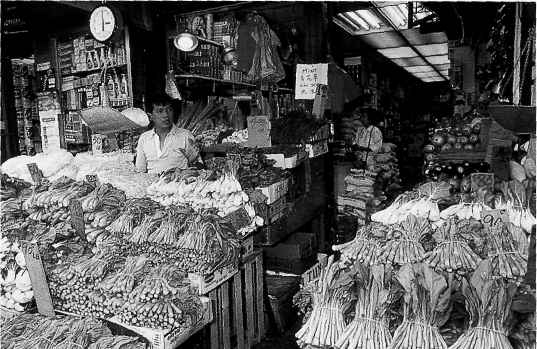 Money is an article which may be used Money is an article which may be used as a universal passport to everywhere except heaven, and as a universal provider of everything except happiness. Wall Street Journal Two women make a market; three make a fair. Recommended grammar: Ukrainian proverb Reported Speech. BUILDING-UP YOUR VOCABULARY
Hours of Business Most shops in the United States open at 9:30 or 10:00 a.m., Monday through Saturday, and close between 5:00 and 6:00 p.m. Larger stores are often open until 9:00 p.m. during the week, and from 10:00 a.m. till 5:00 p.m. on Sunday. Offices tend to have business hours between 9:00 a.m. and 5:00 p.m., Monday through Friday. Sales Tax 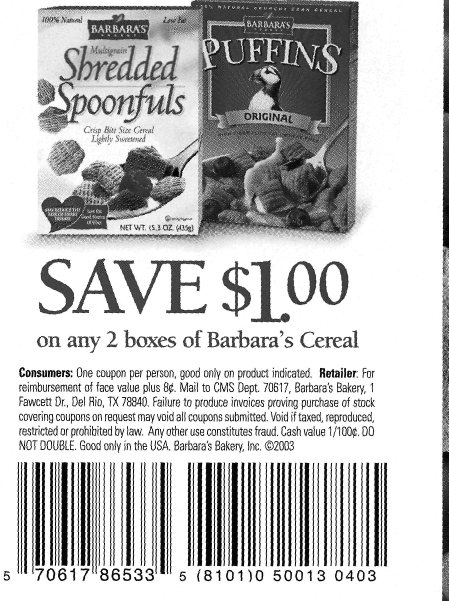 Cities and states have the right to charge an additional percentage of the cost of some items in order to raise revenues. In most places, a sales tax of up to 10% of the price is added to the bill for many non-food items. Taxable items may include prepared food, technical equipment, books, records, clothing, cigarettes, alcoholic beverages, paper products, household products, appliances, cameras, and film. You should be aware that the prices listed on items in stores do not include sales tax. Sales tax will be added to your bill by a cashier. Cities and states have the right to charge an additional percentage of the cost of some items in order to raise revenues. In most places, a sales tax of up to 10% of the price is added to the bill for many non-food items. Taxable items may include prepared food, technical equipment, books, records, clothing, cigarettes, alcoholic beverages, paper products, household products, appliances, cameras, and film. You should be aware that the prices listed on items in stores do not include sales tax. Sales tax will be added to your bill by a cashier.Making a Purchase When entering a store, you may be asked to leave bags, backpacks, or large purses, etc. with a store clerk behind a counter. You should retrieve your bag as you exit the store, after you have completed your purchases. To purchase items in stores in the U.S., you should bring the items you wish to purchase to a cashier. The cashier will total the cost of the items you wish to buy using either the price written on the item itself, or a bar code which is electronically scanned for a price code stored by the cash register. When the cashier totals all the items and adds any applicable tax, you should then pay for your purchase. The cashier will put the items in a plastic or paper bag and hand it to you. The cashier may also staple the bag shut for security reasons. Many newspapers provide coupons that offer discounts on certain items. Check expiration dates at the bottom of the coupons before using them. Present them to the cashier before your items are totaled. b) Scan these receipts in order to pick up the sales tax rates in different stores around the US (IL stands for Illinois, TX – for Texas, MD – for Maryland). Which receipt has no sales tax? Why? 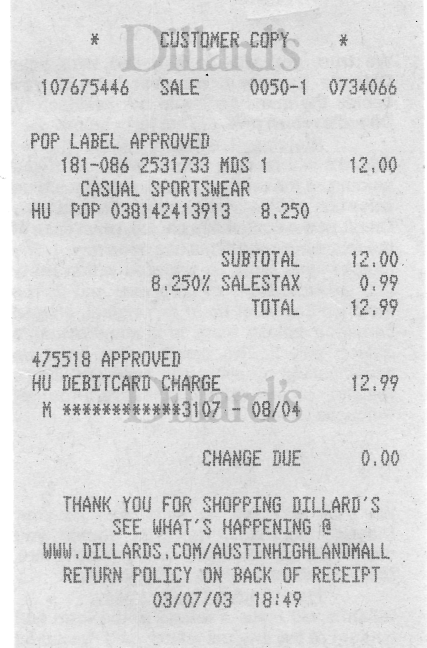 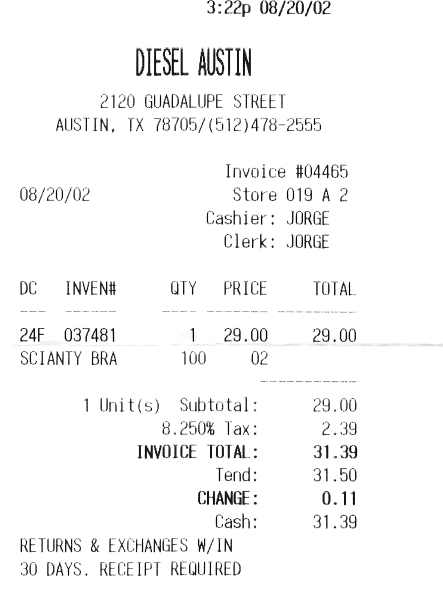 2.2. a) Where do you usually buy food in Russia? Read the text about food shopping in the US and pick up the main features of all food stores. b) Compare them with similar stores in Russia. a) Food Shopping Food shopping in the U.S. can be done in four main types of stores: supermarkets, grocery stores, convenience stores and delis. Supermarkets, the largest of these, departmentalized, self-service stores carry a wide variety of edible items - dairy products, cereals, bread and baked goods, prepared, canned and frozen goods, ice cream and dessert foods, beverages, and non-edibles - paper products (toilet paper, facial tissue, paper plates and napkins, etc.), personal care products, cigarettes, film, housewares and non-prescription drugs. Some supermarkets also have salad bars, film developing services (in general, it costs about $7.00 or $8.00 per roll of 24 exposures for developing and standard prints) and pharmacies. Depending on a state’s laws, supermarkets may also carry wine and beer. Prices of items are usually clearly marked on the packages, or on signs near the items. Supermarkets usually have baskets and carts for carrying items around the store. They generally have several cashiers and use both manual and electronic pricing scanning (the cashier passes a coded tag in front of an electronic scanner and a price is automatically entered into the cash register). In general, supermarkets are open from Monday to Friday from 9 a.m. to 6 p.m., and on Saturday from 10 a.m. to 4 p.m. Some supermarkets are open on Sundays as well. Many supermarkets are now open 24 hours. Most supermarkets are either closed on major holidays, or are open fewer hours. The general consumer appeal of the supermarket concept — large size, self-service, variety of merchandise, one-stop shopping, ample parking, and low prices — ensured their growth. The building of such stores in suburban areas was important in the development of the retail complexes that came to be known as shopping centers, or malls. Today, supermarkets are operated by chains of various sizes and by independent owners. The supermarket concept is gaining increasing popularity throughout the world. Other lines of retailing have adopted some of the supermarket methods of low-cost mass distribution. Grocery stores, a bit smaller than supermarkets, may carry most of the same types of products, but in smaller quantities and with less variety (for instance, they may not have a large selection of fresh vegetables; or they may sell only one commercial brand of a particular item). Grocery stores do not usually have film developing services or pharmacies. Depending on a state’s laws, grocery stores may also carry wine and beer. Prices in grocery stores are usually similar to those of supermarkets. As in supermarkets, the prices of items are usually clearly marked on the packages, or on signs near the items. Grocery stores also usually have baskets and carts and several cashiers. In general, grocery stores usually keep the same working hours as supermarkets. Convenience stores (called this because of their hours of operation - usually from at least 7:00 a.m. to 12:00 p.m. and sometimes 24 hours a day) carry a very limited selection of goods and brands. These stores may carry some canned, prepared and frozen goods, beverages, breads and baked goods, and paper and health care products. Prices for items can sometimes be twice that of supermarket prices. When prices are not marked clearly, it is a good idea to ask about the prices of items before the cashier totals the items you wish to purchase. Delis usually carry only cold cuts (sliced ham, turkey, salami, chicken, roast beef and cheese, etc., prepared for use in sandwiches), breads, beverages, and condiments. Some delis also carry selections of prepared foods and other items. Other types of specialized food stores include baker’s/ bakery, butcher’s, confectioner’s/ confectionery, dairy, greengrocer’s, fishmonger’s, fruiterer’s, sweet-shop, off-license shop/ wine and spirit merchant’s, and tobacconist’s. 2.3. What would you buy in the following shops? florist's greengrocer's baker's butcher's tobacconist's pet shop grocer's newsagent's antique shop stationer's 2.4. Study the vocabulary used to describe shopping. Practice saying all the words of French origin. Consult a dictionary if necessary. General vocabulary: retail, wholesale, shop/ store, chain, mail-order firm, booth, stall (kiosk), rag fair, shop-window / window display, to dress shop window, show-case/ case/ glass cabinet, counter, check-out point, cash-desk, salesman/ saleswoman/ shop assistant, customer /shopper/ consumer, consumer goods, shopping queue/ line, to do one's shopping/ to go shopping, shopping spree [spri:], impulse buying, bargain, to buy/ to purchase/ to shop for, to sell/ to supply/ to deliver (goods), to display (goods), to be in (full) stock, to be out of stock, cheap, expensive /dear, to cost, price, at a price, discount, at a discount, sale, sales tax, mark-down, boutique [bu'tik], scales; open from 9 am to 6 pm; Monday to Saturday; closing (opening) time; to attend (to)/ to serve, to be attended to / to be served, to wrap, fitting /changing room; to try on, to be stock size, to take size...gloves collar, to wear shoes size ..., to be dress size ..., to fit, to be a misfit, to suit/ to become, to match/ to go with, to look (well); style/ design, cut, fashion /vogue, to come into fashion, all the vogue/ all the rage, up-to-date, stylish, dowdy, drab, to be long-wearing, to wear well, to be shrink proof, to be colour-fast / fade proof, to be shower proof / waterproof/ water repellent, to be crease-resistant, to wash well, to dry soon, to afford; to run out of smth. to run short of smth. - I've run out of flour. to stock up - I usually stock up for the week on Saturdays. to be well stocked, that will do, will this do? - I'd like a couple of big apples. - Will these do? we've just got/had.....in, to be out of stock to have sold out - Have you got vinegar? - We've sold out/we're out of stock. to buy/sell....loose/ piecemeal; to sell smth. by weight/by the head; I’m 91-61-91 (i.e. 91 centimeters round the bust, 61 round the waits, 91 round the hips). He’s grown out of his shoes. Adjectives describing price and attitude to money: free, cheap, reasonable, quite /very/ incredibly expensive, skinflint, thrifty; Words and phrases about money: to spend money on smth., at a price, to pay for, to cost, to charge (He charged me $100 = He asked me to pay $100), to lend, to borrow, to waste, to save up, to change, change, to buy on credit/installments, pay a deposit of … pounds; How much is it? / What does it cost?/ What's the price of...? /What price is this...?/ How much is this watch worth?/ What is the value of it? – It’s worth about $50. How do you pay? – (In) cash/ by cheque/ check/ by credit card. Women's outfitter’s or Men's outfitter's: This skirt is too tight and too short – it needs letting out and letting down. The dress is too loose and too long – it needs taking in and taking up. Ready-made clothes/ Ready-to-wear/ Off-the-peg: garments, dress /frock, gown, pinafore dress, dressing-gown, housecoat, blouse, skirt, shirt, trousers/ pants, slacks, jeans, suit, lounge suit, jacket, dinner jacket (AmE tuxedo), tailcoat/ tails, coat, fur-coat, raincoat /mackintosh, parka, wind jacket, wind cheater, (AmE wind breaker); Sports shop /sports outfitter's: sportswear, sport equipment; Shoe shop /Footwear: shoes, pumps, boots, high fur-lined boots, wedge-heeled shoes, shoes with high stiletto heels, shoes with no pointed toes, shoes with long pointed toes, laced (shoes, boots), sandals, slippers/trotters (AmE mules), shoes with a zip, covershoes / galoshes (AmE rubbers), Wellingtons, trainers, running shoes, tennis shoes; suede / chamois, patent-leather, canvas shoes, leather-soled, rubber-soled, flat-heeled (with flat heels), high-heeled, with a small buckle, with a narrow bow, shoe horn, shoe polish; to have wide/ narrow feet, to have fallen/ high arches; I have a high instep so I am only comfortable in a low-cut shoes. I’ve rather a broad foot. Milliner's: hat, cap, beret, panama hat, sun hat; Knitted goods /wear: cardigan, sweater, jumper, pull-over/ jersey; Hosiery: socks, stockings, tights /panty-hose, knee-high stockings, knee-length socks; Linen: sheet, pillow-case, blanket slip, bed-cover, table cloth, napkin; Women’s underwear: lingerie, slip, waist-slip, bra /brassiere, panties, briefs, bikini briefs, vest; Men's underclothes: sleeveless vest, short-sleeved vest/T-shirt, briefs, trunks, long Johns; Jeweller’s: ring (engagement ring, wedding ring), ear-rings, necklace, brooch, pendant, bracelet, anklet, silverware; Perfumery /Cosmetics: perfume / scent, cream, lipstick, varnish, powder, eye-shade, mascara, make-up; Style: long-sleeved, V-necked, round-necked; General description of clothes: elegant, smart, scruffy, chic, trendy, with-it; Appearance: impeccable, well-dressed, badly-dressed, old-fashioned, fashionable; Textiles: satin, velvet, cotton velvet, cotton, nylon, serge (for lining), print, linen, pure-wool cloth, tweed, silk (natural, artificial), leather, kid, tartan, stockinet / knitted, lace, fringe; Patters and colours: plain/ solid (AmE), flowered, background, striped, pin-striped, tartan/ plaid (AmE), chequered/ checkered (AmE), polka dot /dotted, spotted, zigzag, rich colour, carmine, coral, crimson, pinkish, purple, beige, copper, khaki, pistachio, azure; Haberdasher's: thread reel, yarn, tape, ribbon, needle, knitting-needle, pin, safety-pin, button, hooks, clasps, gloves, mittens, muffler/ scarf, toiletries; Antique shop and art shop: valuable old articles, bric-a-brac, painting, water-colour, engraving, etching, sculpture, books on art; Record shop and newsagent's: records, newspapers, magazines, posters, paperbacks, greeting cards, plain/picture postcard, envelopes, stamps; Chemist's /druggist's/ drugstore: drugs /medicines and related articles; Bookseller's /bookshop and Stationer's (AmE stationery): note paper, writing paper, writing pad, wrapping paper, carbon paper, notebook, file, diary, paper clip, drawing pin, ruler, rubber/ eraser, fountain pen, ink, ball-point pen, refill, fibre / felt-tip pen; Florist's /flower shop: plant,pot plant, wreath, bouquet ['bukei], seed; Furniture shop: bedroom suite [swi:t], sitting-room suite, blind, curtains; Ironmonger's /hardware shop: spade, nail, hammer, screw, nuts, screwdriver, gardening tools, watering-can, bucket / pail; China shop: china /porcelain, glassware, pottery /ceramics, crockery (ware); Household goods: tableware, dinnerware, kitchen utensils, iron, broom, mop, electric appliances. 2.5. Read the text below and answer the questions after the text. Non-Food Shopping Malls are the places where many Americans go to shop for all kinds of goods. A mall is a large building containing many different kinds of stores, including big department stores and small specialty stores. Specialty stores sell everything from electronics to cosmetics to imported coffee. Malls are usually indoors, but some “strip malls” are outdoors. Department Stores are large stores where you may purchase items such as jewelry, perfume, clothing, shoes, appliances, televisions, radios, bicycles, furniture, etc. You may also find some personal care and food products, as well as film processing in department stores. While most merchandise is kept on easily accessible shelves, some small valuable items (such as watches, cameras and jewelry) may be kept in locked glass cabinets. You may ask to see and examine most of these items. The procedure for purchasing merchandise is the same as the one in most other stores: you bring the merchandise to a cashier's counter; the cashier totals the cost of the merchandise; and you then pay the cashier. The cashier usually hands you the merchandise in a plastic or paper bag. Discount Stores such as Wal-Mart, K-Mart, and Target can be found in most cities and towns. These are very large stores that usually offer department store items and some grocery items at lower prices. They are able to offer lower prices because they offer fewer services and less attractive shopping areas. Campus bookstores carry textbooks required for classes, as well as supplies such as notebooks, pencils, pens, folders, etc. Campus bookstores also carry stationery and gift items. Drugstores sell medications. There are two types of drugs available, over-the-counter and prescription only. Prescription drugs require written permission from a doctor in order to obtain them. Over-the-counter drugs such as aspirin, cold medicine and stomach medications can be bought without first seeing a doctor and are available at almost any type of food or drug store. If you get a prescription from a doctor, you should go to a place which has a pharmacy to get your medications. Drug stores in the U.S. often carry more than pharmaceutical supplies. You may also find personal care products, perfume, non-prescription drugs, film, cigarettes, small appliances, greeting cards, and gift items. Some drug stores also carry some food products and have film processing services. Liquor Stores. In some states, it is legal to sell beer and wine in supermarkets, grocery stores, convenience stores and delis. In other states, beer, wine and liquor are sold only in liquor stores. Liquor stores in many states are closed on Sundays. State laws restrict the purchase of alcoholic beverages to people aged 21 and over. Stores, restaurants and other establishments are subject to strict fines and penalties if they sell alcoholic beverages to people under 21. Therefore, in order to purchase these items, you may be asked to show a picture identification card. Also, it is illegal to have an opened container of beer, wine or liquor in a car or other public places like sidewalks, parks and buildings. Alcoholic beverages must be consumed in private homes, in restaurants, and other such places which have a license to serve liquor. Questions: 1. What is the difference between malls, department and discount stores? Are there any stores of these kinds in your city? Do they have similar or different features compared to the American stores? 2. Are there any campus stores in your city? Where do students (ordinary people) usually buy books for studies? 3. Do you need a prescription to buy medicine at American drugstores? What about the situation in Russia? 4. Where can people in Russia buy liquor? Where do Americans buy it? 5. How do laws in the US restrict purchase of alcohol? Are there any similar laws in Russia? 2.6. a) Put each of the following words or phrases in its correct place in the passages below. a) cash desk sales tag label off-the-peg refund try on fit receipt assistant mail order bargain till cashier exchange If you want to buy a ready-made (or we sometimes say (a) _____) jacket, first find the jackets in the shop and look at the (b) ______ inside to see the size, material and make. For the price, look at the price- (c)______. To see if it will (d) ______ you, you can (e) ______the jacket in front of a mirror. If necessary an (f) ______ will help you. You pay the (g) ______, who you will find at the (h) ______. He or she will take your money, put it in the (i) ______and give you your change. Make sure you also get a (j) ______, which you should keep and bring back to the shop with the jacket if something is wrong with it and you want to (k) ______it or ask for a (l) ______of your money. In clothes shops you pay the fixed price, of course. You don't (m) ______. Or you can wait until the (n) ______, when many goods are reduced in price. If you don't like shops, you can stay at home, look at catalogues and newspaper advertisements and do your shopping by (o) ______. b) slavishly trends slaves to fashion individualists trendy fashion houses conformists dictate the latest fashion haute couture dictates personal ornaments Most people like to think they are (a) ______and simply wear whatever they like. Few people will admit to being (b) ______. However we are not just talking of the expensive (c) ______ of the Paris and Milan (d) ______, which not many people can afford anyway. We are talking of fashions and (e) ______ in everyday clothes. We say that we wear jeans and sweaters because they are cheap and practical, but isn't it true that our jeans and sweaters tend to be the same as everyone else wears? Doesn't that mean that we like to be (f) ______? Of course the big chain-stores, to some extent, (g) ______what we wear, but they always offer a choice and people do, on the whole, like to wear (h) ______, which extends beyond clothes to make-up, (i) ______ (men wear earrings too, nowadays) and hair styles. It is easy to declare that we do not (j) ______follow the (k)______of fashion, but aren't we all (l) ______ at heart? b) Match the phrase on the left (a-o) with the corresponding definition (1-15) on the right. (a) dress down 1) smb. strongly influenced by fashion (b) smart-casual clothes 2) wear less formal clothes (c) dressy 3) informal, but clean and stylish clothes (d) skimpy 4) start a new fashion (e) baggy 5) to become popular (f) snazzy 6) to wear clothes intended to attract people’s attention (g) to be dressed to kill 7) very expensive clothes (h) designer/ label clothes 8) have new ideas before they are fashionable (i) off the peg/rack or on the high street 9) modern, stylish (j) all the rage / the height of fashion 10) close-fitting, using little material (k) up-to-the-minute 11) very fashionable (l) set a new trend 12) dealing with the most recent trends (m) ahead of one’s time 13) loose (n) to catch on 14) cheaper clothes (o) a slave of/ to fashion 15) suitable for formal occasions l 2.7. Match each of the following parts of clothing with the correct letter in the pictures below. abel heel collar lapel sole seam pocket buckle zip crease sleeve belt laces toe lining cuff button 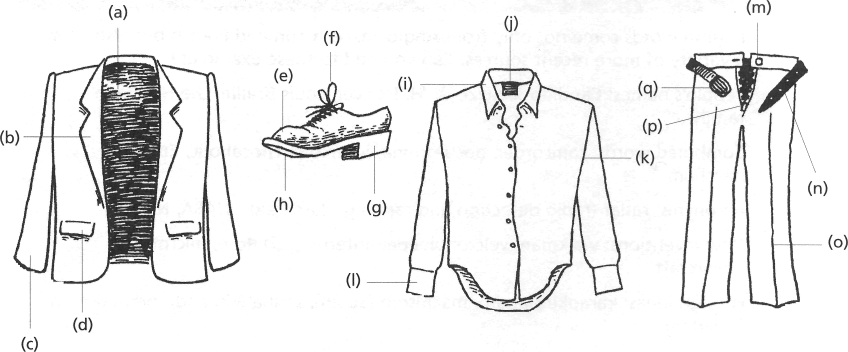 2.8. a) Match each material on the left below with the most appropriate word, phrase or phrases on the right. (a) corduroy a ship’s sail, a boxing ring (b) canvas church windows (c) denim the roof of a shed or cheap hut (d) fur comfortable soft trousers (e) frosted glass jeans (f) stained glass bathroom windows (g) stainless steel a woman’s expensive, warm coat (h) corrugated iron a wall (i) straw a man’s old-fashioned light summer hat (j) brick cutlery (k) cork old ships (l) silk packing material (m) suede fine cups, saucers, dishes (n) linen a wine-bottle stopper (o) serge shoes, a casual jacket (p) corrugated cardboard a lawn (q) tweed a woman’s expensive evening dress (r) timber fine bed-sheets (s) porcelain a man’s hard-wearing sports-jacket (t) turf an ordinary soldier’s uniform b) What materials, from those above, might the following items be made of? a football pitch a man’s tie table-mats the lining of a winter coat a woman’s casual skirt tents a household lamp base a dentist’s surgery windows a house a cheap casual jacket a table-cloth an overcoat an oil-painting base a woman’s purse a watch-case a baby’s toy animal ( 2.9. Put the correct form of ‘wear’ or ‘dress’ in the spaces below. a) Students normally _______ very informally. (b) She often _______ in black. (c) They usually _______ jeans and sweaters. (d) They were _______ in jeans and sweaters. (e) What were they _______? (f) How were they _______? (g) He can wash, shave and _______in ten minutes. (h) She was _______ an evening _______. (i) The men were in evening _______. (j) It’s informal. There's no need to _______up. 2.10. Put one of the following words in each space in the sentences below. on in off up for with at by inside back
2.11. Explain the difference between the following. (a) to overcharge and to undercharge (c) a shopkeeper and a shoplifter (b) shopping and window-shopping (d) a wholesaler and a retailer 2.12. a) Study the English words for containers below. b) Then match each container (a-r) with its contents (1-18). 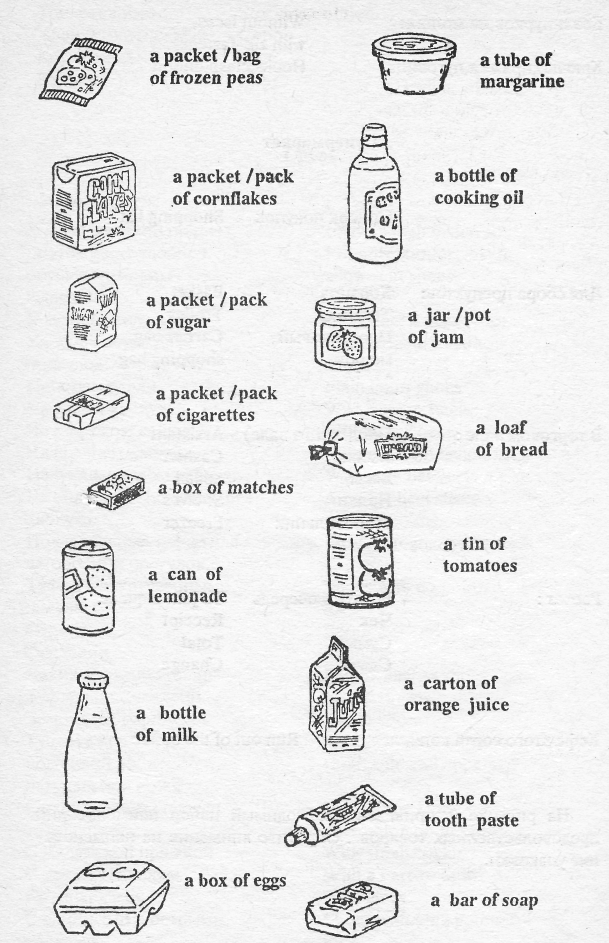  b) (a) basket (1) clothes and personal things for a long stay (b) trunk (2) coins (c) tank (3) bank notes, tickets (d) safe (4) shopping (e) vase (5) petrol, water (f) purse (6) suits, jackets, dresses (g) wallet (7) cash, secret documents, jewellery (h) kettle (8) boiling water (i) wardrobe (9) flowers (j) briefcase (10) school books (k) envelope (11) clothes and belongings for a week's holiday (l) jug (12) letter (m) suitcase (13) water, milk (n) barrel (14) waste paper (o) satchel (15) beer (p) bin (16) hot tea, cold drinks (q) box (17) business papers (r) (thermos) flask (18) chocolates, matches 2.13. The following words represent small pieces or quantities. Put each in its correct place in the sentences below. In (a) some words must be used more than once. a) glimmer grain fragment dot shred crumb blade trace speck (a) She was very house-proud. There wasn't a ______ of dirt in her kitchen. (b) They were so hungry they ate the whole loaf of bread without letting a single ______ fall to the ground. (c) The desert stretched for miles. Nothing green. Not a single ______ of grass. (d) We watched the ship as it sailed away until it was just a ______ on the horizon. (e) His views are dangerous and extreme, and yet there is a ______ of truth in what he says. (f) The accusations against him are completely groundless. There isn't a ______ of evidence to support them. (g) Archaeologists are examining a ______ of a vase which they think is over 5,000 years old. (h) There now seems to be a ______ of hope that the strike will be averted. (i) The famine is so bad in that area that the people haven't seen a single______ of rice for weeks. (j) One day in June 1987, he suddenly disappeared without ______ and no one has seen him since. (k) The police found a tiny ______ of lipstick on the wineglass. b) hint clue breath flake drop puff dash item scrap (a) “Whisky?” - “Well, just a ______, please.” (b) Don’t ask me about the economic situation. I haven’t a______. (c) I’m just going out for a ______ of fresh air. (d) I watched a rain-______trickling slowly down the window. (e) I’d like my coffee almost black please. Just a very small ___ of milk. (f) “What a lovely smell. What is it?” – “Some spices and I think some seafood and also just a ______ of lemon.” (g) I wrote the phone-number down on a ______ of paper I tore from an envelope. 2.14. a) Study these words and expressions connected with clothes (1-9) and shops (1-6) used metaphorically and match them with their definitions on the right. Think of their Russian equivalents. Clothes metaphors: 1) off the cuff (a) (usually of a woman) be the dominant partner in a marriage 2) to be hand in glove with someone (b) involving mystery and secrecy 3) cloak-and-dagger (c) simple and plain 4) to have/ take the shirt off smb’s back (d) spending as little as possible 5) (to do smth.) on a shoestring (e) have a close working relationship with someone 6) without frills (f) restrict smb’s freedom 7) to put someone in s strait-jacket (g) without having prepared anything 8) to wear the trousers (h) to deprive smb. of his/her last possession 9) shop around Shop metaphors: 1) to set up shop a) to discuss smb’s work 2) all over the shop b) to begin doing something 3) to shop around c) to stop doing something, working 4) to shut up shop d) to compare prices, quality of goods at several shops before buying anything 5) to talk shop e) a meeting where things are discussed but no action is ever taken 6) a talking-shop f) spread out everywhere b) Explain the meaning of the following idioms and use them in your sentences. hem in, burst at seams, cloak in, feather in one’s cap c) Many idioms are based on colours. Put each of the following phrases in its correct place in the sentences below. a) out of the blue in black and white green with envy in the red a black sheep to have green fingers once in a blue moon red tape to catch someone red-handed (a) The offer of a job sounded very good on the phone, but I shan’t believe it till I have it______. (b) I must remind you that this is a non-smoking office. I suspect that some of you have been smoking. If I happen______, I’m afraid it will mean dismissal. (c) To import firearms into Britain you’ll have to fill in a lot of forms. There’s a lot of______. (d) If you want to be a successful gardener, of course you’ve got______. (e) The rest of the family were respectable, honest people, but he was always in trouble. I'm afraid he was______. (f) When I saw him in a new sports car, I was______. (g) Tourists often go to the Louvre, but most Parisians only go______. (h) The firm is______. It owes a lot of money. (i) I had lost touch with Jack, and then one night he arrived at my flat right______. What a surprise! b) red-carpet treatment to see red rose-coloured spectacles a red herring a white-collar job a green belt blue-eyed boy a white lie (a) Naturally the President’s wife received ______ on her visit. (b) He said he didn’t want to have ______ and sit in an office all day. (c) All round the city there is ______ of open country where building is restricted. (d) She loves animals and tends ______ when she sees one being badly treated. (e) He told _____ to avoid hurting his wife’s feelings. (f) Everyone thinks he’ll be Director of the firm one day. He’s the ________. (g) Be realistic. You can’t go though life looking at the world through _______. (h) In class pupils sometimes introduce _____ to distract the teacher from his subject. 2.15. Put each of the following words or phrases in its correct place in the passage below. Do people in Russia use their personal finance similarly? Be ready to give a short presentation in class on the way people use their personal finance in Russia. current account withdraw bargain buy in bulk savings account mortgage salary bank statement bank loan rip-off on credit deposit overdraft fee discount refund be in the red receipt haggle outright fare In a bank you usually have a (a) _______, which is one where you pay in your (b) _____ and then (c) _________ money to pay your everyday bills. The bank sends you a regular (d) ________ telling you how much money is in your account. You may also have a (e) _______ where you (f) _______ any extra money that you have and only take money out when you want to spend it on something special. You usually try to avoid having an (g) ______ or you end up paying a lot of interest. If your account is overdrawn, you can be said to (h) _______ (as opposed to in the black or in credit). Sometimes the bank may lend you money - this is called a (i) ______. If the bank (or building society) lends you money to buy a house, that money is called a (j) _____. When you buy (or, more formally, purchase) something in a shop, you usually pay for it (k) ______ but sometimes you buy (l) _______ (on installments). Sometimes you may be offered a (m) ________ or a reduction on something you buy at a shop. This means that you get, say, £10 off perhaps because you are a student. You are often offered a discount if you (n) _________. It is not usual to (o) ______ about prices in a British shop, as it is in, say, a Turkish market. If you want to return something which you have bought to a shop, you may be given a (p) _______, i.e. your money will be returned, provided you have a (q) _______. The money that you pay for services, e.g. to a school or a lawyer, is usually called a (r) ______ or fees; the money paid for a journey is a (s) _____. If you buy something that you feel was very good value, it's a (t) _____. If you feel that it is definitely not worth what you paid for it, then you can call it a (u) _____ (very colloquial). 2.16. Study the information about money, weights and measures in Great Britain and the USA. Remember the new words. English Money Pound or Pound Sterling, monetary unit (currency) of the United Kingdom, is represented by the symbol £. Historically, the terms pound and pound sterling originated in Anglo-Saxon Britain during the 8th century when the basic monetary unit, called a “sterling,” was made equivalent to 1/240 of a pound of silver and 240 sterlings became known as a “pound of sterling.” The pound was convertible into silver until 1717. The British system of money used to be rather difficult. The British pound used to consist of 20 shillings, each of which was worth 12 old pence. Besides these, there were also halfpence (1/2 p), twopence ['tʌpens], three halfpence (or a penny-halfpenny, 1 1/2 p) [ɵri:'heipəns], threepence ['ɵrepnəs], sixpence (6 p), farthings (1/4 p), two-shilling piece, and half-crowns (2 shillings and 6 pence). On February 15, 1971, the pound’s coinage equivalent was changed to the decimal system, from 20 shillings to 100 pennies, replacing the traditional shillings and pence that had been used since 11th-century Anglo-Norman times. At present they use 1-pound, 5-pound, 10-pound, 20-pound, 50-pound notes and coins – 1 penny, twopence, 5 pence, 10 pence, 20 pence, 50 pence (p [pi:] for pence in prices: 50 pence – 50 p), 1-pound and 2-pound coins. American Money The American unit is the dollar - $. In the dollar there are 100 cents (c), 1-cent coin is often called penny. А 5-cent coin is called a nickel, and a 10-cent coin - a dime, a 25-cent coin – a quarter. |
